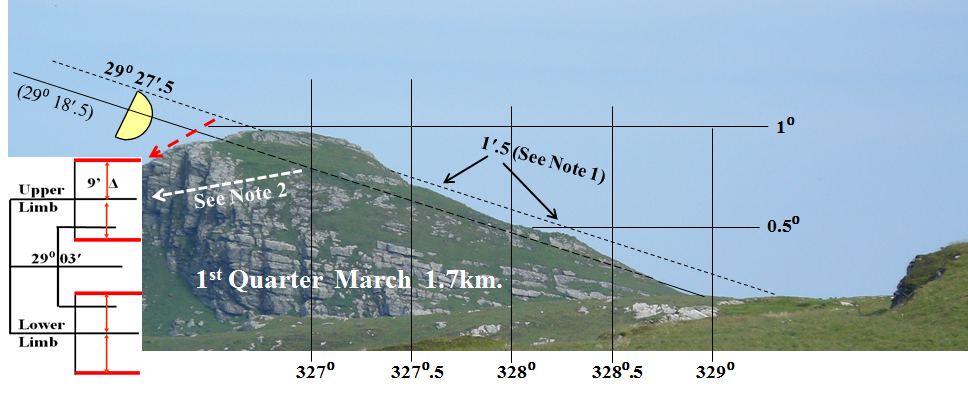Ballinaby IS15 (Map ref. 2200 6719)
The site is in North West Islay. It was visited by Pennant in 1772 who wrote of "Three stones of stupendous size". Only one of these stones now remains but it is one of the finest in Scotland. 5.0 x 1.1 x 0.3 m.
The rocky outcrop about 1.7 km. to the North West and near the coast is well indicated and is an obvious feature. It provides a foresight for the setting moon at the extreme North.
Note 1. The great majority of the other 15 lunar sites give declinations within less than 1′ arc of the theoretical value. 1′.5 would usually be considered very good but in the present context, not so good. Why then is it not less? The probable answer lies in the fact that the upper limb is being observed, and it has to be visible. (See note 3) There are two good foresight regions as marked and by having the maximum declination position as shown would make the moon more visible.
In all of this, it must be borne in mind that even as the moon reaches its maximum declination during any lunation it will only be within (say) 2′ arc of the maximum for about 9 hours in total. 12 hours before/after the maximum it will be about 11′ arc short of the maximum declination. So it desirable to be able to see it perhaps 15′ declination less than the maximum so that results can be obtained for extrapolation. At Ballinaby the maximum visibility is after it reappears at the bottom corner. About 10′ arc. (The visibility of the moon as it approaches the maximum could be improved if the observer moves to the right. 10m right improves the visibility by about 7′ arc.)
Note 2 Thom (1978, pp169-170) considered the reappearance of the moon at the bottom corner was for the 'no wobble' declination. However it is not possible to observe such a position without already knowing where it would be from other observations. See Discussion; Supposed 'no wobble' alignments.
Note 3 As discussed above the upper limb is somewhat awkward to observe. The lower limb is much easier. e.g. as at Nether Largie (Argyll), Port Ellen (below) and Torbhlaran (Argyll). The problem is the rising ridge seen to the right in the main image. This is about 550 metres away. To obtain the required change in declination (31′ arc - the diameter of the moon) would require the stone to be about 41 m. to the right. This would result in the said ridge obscuring most of the foresight feature and so it was not an option


